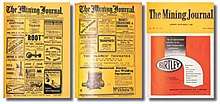The Mining Journal (trade magazine)
The Mining Journal covers global mining investment, finance, and business.
Origins
The Mining Journal was founded in 1835 in London by Henry English, a London stockbroker[1] under the name of Mining Journal and Commercial Gazette. In 1860 it was renamed to Mining Journal, Railway and Commercial Gazette and by 1910 it was called Mining Journal. In the early days of Mining Journal, then known as Mining Journal and Commercial Gazette, it carried information on a range of subjects, from mines, machinery and metals prices, to news items and stories of general interest. The early issues also provided a glossary of mining terms, updated regularly, and noted all known mine accidents.
In 1963, The Mining Journal Ltd. took over rival publication, Mining Magazine, which had been founded in 1909 by Herbert Hoover, later to become President of the US, while he was a mining engineer then working in London. In 1935, as a centenary edition, it launched Mining Annual Review and in the 1990s expanded through the launch of World Tunnelling, Geodrilling International, Mining Environmental Management (now Mining People and the Environment) "[2]
In 1844, the Mining Journal successfully campaigned for the introduction of the first safety regulations for mines.[3]
A large number of important inventions were introduced in the 1830s, and it is clear from the early issues that the founders – led by the first editor, Henry English – realized they were witnessing an evolution in mining.
Michael Coulson, author of The History of Mining, wrote that English believed with the Industrial Revolution in full swing and the mining industry providing the key raw materials driving industrialization, “a regular publication recording and commenting on the issues facing mining was long overdue” [4]
“Exposed to the oxygen of publicity it was clear that all was not well with the UK’s mining industry – its size, excepting coal, was inadequate to provide all the needs of rapidly growing industries such as iron, steel and engineering,” Coulson wrote.
“At the same time, coal mining in the UK was dangerous and fatalities unacceptably common in the fast growing industry.
“English became something of a one-man protest movement and his commentaries became increasingly influential, culminating in his success in having a commission appointed to look into the Haswell Colliery disaster in Durham in 1844 following his direct appeal to Queen Victoria.
“The Mining Journal continued to campaign for reform of the mining industry and English’s efforts played a major part in the establishment of both the Royal School of Mines and the Camborne School of Mines.”
The British Geological Survey also dates back 180 years, with the formation of the Ordnance Geological Survey in 1835. As indicated, Mining Journal campaigned vigorously for greater safety in mines and for the establishment of mining schools – the Royal School of Mines opened in 1851 and Camborne School of Mines early in 1888.
Up until 2005 it was owned and managed by independent company, Mining Journal Limited and that year ownership was transferred to publishing company, Mining Communications, which also produces Mining Magazine, Mining, People and the Environment, GeoDrilling International and World Tunnelling/Trenchless World.[3][5] Since 2008, it has been owned by the Australian company Aspermont.
References
- Coulson, Michael (2012). The History of Mining. Harriman House. pp. 138, 401. ISBN 9780857192660.
- Wilson, A.J. The Pick and The Pen. London: Mining Journal Books Limited, 1979.
- Chronology of The Mining Journal (Subscription or registration necessary).
- "Michael Coulson - Author Profile". www.harriman-house.com. Retrieved 2016-03-03.
- Mining Communications "Mining Journal Online" website.
